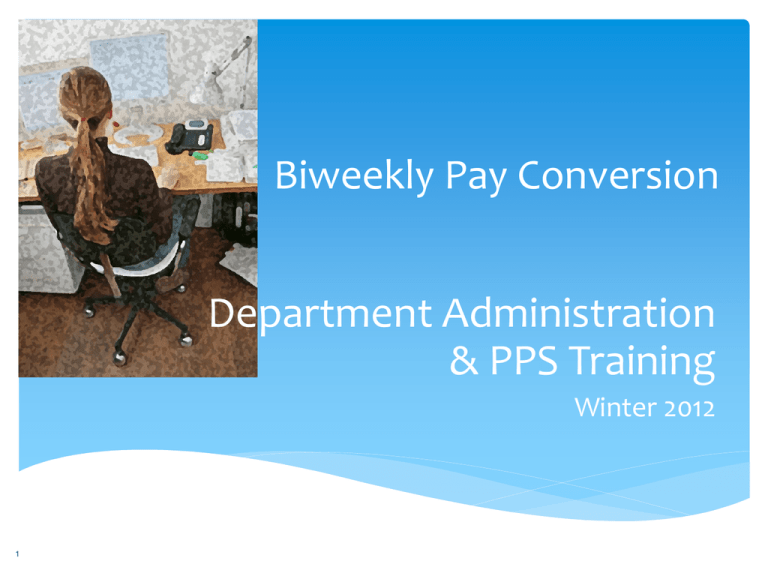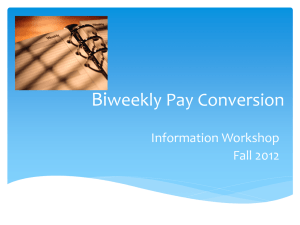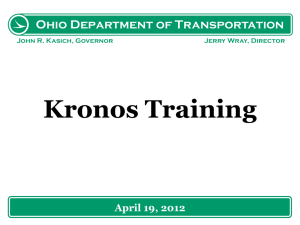Biweekly Pay Conversion
advertisement

Biweekly Pay Conversion Department Administration & PPS Training Winter 2012 1 Topics 2 Biweekly Basics 2013 Pay Cycle Calendar Pay Transition Period January-February 2013 Transition Assistance Program Administration PPS Time Reporting Process & Schedule Timekeeping (Timecards & KRONOS) Leave Accrual and Reporting PPS Conversion Implementation Resources Biweekly Basics A biweekly pay cycle consists of 10 working days (2 weeks), Sunday through Saturday Paychecks are issued on the second Wednesday after the pay period ends Employees receive pay every 2 weeks, on every other Wednesday. Note that pay is every other week, NOT twice a (calendar) month. Actual pay dates will vary month to month Most months will have 2 paydays, but some will have 3 3 Biweekly paycheck deductions Percent-based deductions will be deducted from every paycheck Examples: Taxes, retirement contributions, etc. Flat-dollar deductions will be split across 2 biweekly paychecks Examples: Insurance premiums, parking, etc. For months with 3 pay cycles, the 3rd paycheck (paid the following month) will have NO flat-dollar deductions (but will still contain percent-based deductions) This paycheck is referred to as a “benefit holiday” In 2013 there will be 2 benefit holiday paychecks: April 10 and September 11 Refer to 2013 Biweekly Pay Calendar 4 Who’s moving to biweekly pay? Non-Exempt Staff Employees Currently monthly-paid staff employees who are eligible for overtime, shift, on-call pay Hourly-paid staff employees who report actual time worked Examples: Student Assistant series, Limited appointments, etc. Data Warehouse Report EZ Access -> Employee -> Non-Exempt Appointments http://wh.isc.ucsb.edu/ 5 Who’s remaining on monthly pay? All Academic Employees Including Readers, Tutors and Teaching Assistants Exempt Staff Employees Currently monthly-paid staff employees who are NOT eligible for overtime, shift, on-call pay Employees holding concurrent exempt and non-exempt appointments Special cases may be biweekly, not monthly HR and/or AP to make determination 6 When will the first biweekly cycle begin? Sunday, January 20, 2013 7 8 Student/Limited Pay Cycle Transition Currently on mid-month to mid-month monthly cycles Final monthly cycle should be extended through January 19th by the department (if not already set up on a 20th-19th schedule) To reflect time worked from mid-December 2012 through midJanuary 2013 First biweekly cycle can then begin on January 20th along with other biweekly employees 9 Paycheck Transition Paycheck Date Paycheck Pay Period January 2, 2013 Last full monthly paycheck December 1 - 31, 2012 February 1, 2013 Last partial monthly January 1 - 19, 2013 paycheck (14 work days) (Full flat-rate deductions) First biweekly check January 20 February 13, 2013 (Flat-rate deductions split February 2, 2013 in half) (10 work days) 10 Transition Assistance Program (TAP) Voluntary program to provide extra cash on the February 1st paycheck (deadline to apply: 1/10/13) Loan $100 - $1,000 interest-free loan Repaid through paycheck deductions First repayment on March 13th paycheck Total 12 biweekly deductions, through August 2013 Employee has option to prepay remaining balance at any time If employee separates from University during repayment period, remaining loan balance is due and payable from final paycheck Vacation/Comp Time Cashout Cash out up to 80 hours of accrued vacation and/or comp time 11 TAP Administration Loan Loan payment and repayment payroll deductions will be fully processed through Payroll and Human Resources departments Vacation Cashout Cash payout and PPS vacation balance adjustment will be processed through Payroll and Human Resources departments Departments need to adjust vacation balance on employee’s timecard or KRONOS Comp Time Cashout Cash payout/PPS comp time balance adjustment needs to be done by departments To be paid on February 1st paycheck Use MO payroll window 1/10/13 – 1/24/13 LX transaction using DOS code “CMP” 12 13 Time Reporting Cycles BW = Biweekly Every 2 weeks MO = Monthly Once a month MS and MA will cease to exist Last MS paycheck January 22, 2013 Window: 1/4/13 – 1/11/13 Last MA paycheck February 7, 2013 Window: 1/23/13 – 1/30/13 14 Biweekly Time Reporting Process To be done for each biweekly cycle POSITIVE time reporting Time reporting will be done in hours For purposes of overtime calculation, workweek is Sunday through Saturday (no longer Monday through Sunday) Paper timecards – will need to enter time via PPS IDTC KRONOS electronic timekeeping system – will upload hours 15 Biweekly Time Reporting Process Biweekly Payroll Cycle Names: “B1” and “B2” B1 + B2 = “quadriweekly” cycle Payroll windows are 2-3 working days after pay period end Generally opens Monday (Tuesday, if Monday is holiday) Closes on Wednesday Manual reporting (paper timecards) through PPS IDTC KRONOS will upload to PPS on Wednesdays at 11:00 a.m. This allows the afternoon for making corrections to file LX transactions generally available through Thursday 5:00 p.m. First Biweekly Pay Window starts Monday, February 4 For biweekly pay period of January 20 – February 2 16 Biweekly Time Reporting Schedule 17 Monthly Time Reporting Process “Exception” Time Reporting – automatic (same as before) MO windows will be available for manual payroll (additional pay, corrections, etc.) and leave reporting BW windows will not be available for payroll transactions for monthly employees Remember that MA and MS cycles are going away 18 Monthly Time Reporting Schedule 19 Biweekly Timecard “Front” Attendance Record • 8 biweekly/4 quadriweekly cycles per card • Record time in the same manner as Non-Exempt Monthly Attendance Record • Enter time worked in top row boxes • Enter paid leave, comp time, etc. in bottom row boxes • Obtain signatures for each biweekly cycle 20 Biweekly Timecard “Front” Record SAMPLE • Each two biweekly cycles (“B1” and “B2”) are paired to form quadriweekly cycles • Report time during each biweekly payroll window • Report leave usage for quadriweekly cycle during “B2” payroll window 21 Biweekly Timecard “Back” Attendance Summary •Top table is Quadriweekly Summary (2 biweekly cycles) for Vacation, Sick Leave and Comp Time •After leave accrual calculation, truncate result to 2 decimal places (n.nn) •Bottom table is Weekly Summary for overtime calculation •Add straight & premium OT/comp together for Quadriweekly Summary 22 Biweekly Timecard “Back” Summary SAMPLE •Multiply quadriweekly hours by vacation and sick leave factors to calculate leave accruals: •Example “B” vacation accrual: 40 hours/week x 2 weeks = 80 per biweekly cycle •80 hours/biweekly x 2 cycles = 160 quadriweekly hours •160 x 0.069231 = 11.076960 •Truncate to 11.07 •Report leave usage during “B2” payroll window 23 Biweekly Timekeeping - KRONOS Non-exempt Career on KRONOS will begin to be paid from an upload directly from their approved KRONOS timecards Students and Limiteds on KRONOS are already paid in this manner So pay will be based on what’s reported on KRONOS timecard Overtime will be included Time is simply reported as “time worked” and KRONOS will calculate overtime per work rules based on the appropriate union contact 24 Monthly Timekeeping Both Timecards and KRONOS – same as before Exempts only Leave taken to be recorded in full days 25 Paid Leave (Vacation & Sick) Transition from table to factor accrual Table: Earn vacation and sick leave in full hours Factor: Earn vacation and sick based on a multiplier Will apply to all Staff, both biweekly non-exempt and monthly exempt employees (does not apply to Academic appts) Biweekly non-exempt Accrual based on hours of pay status during quadriweekly cycle (“B1” +“B2” biweekly cycles) Monthly exempt Accrual based on hours of pay status during calendar month Working hours of calendar month vary, so leave accrual will also vary each month Total accrual over calendar year is the same for table & factor methods 26 Reporting Paid Leave Leave taken by biweekly employees will be reported once every quadriweekly cycle (using “B2” cycle) via IDTC, or through KRONOS upload Leave taken by monthly employees will be reported once a month using PYLV roster, or through KRONOS upload PYLV roster is available for now, but will be discontinued Anticipated discontinuation when KRONOS is fully rolled out to campus Stay tuned for future notices 27 Leave Accrual – Biweekly Accruals are credited on the first day of the following quadriweekly-cycle The next “B1” cycle following a “B1 + B2” quadriweekly cycle How to live with 6-decimal accruals (for timecards) Use full factor to calculate accrual Sick leave accrual rate of .046154 160 x .046154 = 7.384640 Then truncate (don’t round) the result to 2 decimal places 7.384640 = 7.38 on paper timecard “Biweekly Factor Accrual Calculations” chart Geared for 100% appointments 28 Biweekly Factor Accrual Calculations (@ 100% time) Leave Accrual Code Equivalent Table Hours per Month Factor Accrual Rate Factor Hours Earned for 1 Quadriweekly Cycle (160 hrs, @ 100%) Factor Accrual Hours Truncated to 2 Decimals (Paper Timecards) A 10 .057692 9.230720 9.23 B 12 .069231 11.076960 11.07 C 14 .080769 12.923040 12.92 D, K 16 .092308 14.769280 14.76 8 .046154 7.384640 7.38 Vacation Sick Leave All 29 Leave Reporting – Biweekly How and when to report time taken Report time to the nearest ¼ hour Report time taken for the quadriweekly cycle (“B1” and “B2” cycles) during the “B2” payroll window 30 “B2” Leave Reporting - IDTC 31 Leave Accrual – Monthly Accruals are credited on the first day of the following month Accruals will vary from month to month, but… The total accrual for a year using the factor method will come out the same as the total accrual using the table method How to live with 6-decimal accruals Use full factor to calculate accrual Sick leave accrual rate of .046154 0.046154 x 176-hour month = 8.123104 Then truncate (don’t round) the result to 2 decimal places 8.123104 = 8.12 on paper timecard “Monthly Factor Accrual Calculations” chart Geared for 100% appointments 32 Monthly Factor Accrual Calculations (at 100% time) Factor Accrual Rate 160-Hour Month 168-Hour Month 176-Hour Month 184-Hour Month A: 0.057692 9.23|0720 9.69|2256 10.15|3792 10.61|5328 B: 0.069231 11.07|6960 11.63|0808 12.18|4656 12.73|8504 C: 0.080769 12.92|3040 13.56|9192 14.21|5344 14.86|1496 D/K: 0.092308 14.76|9280 15.50|7744 16.24|6208 16.98|4672 7.38|4640 7.75|3872 8.12|3104 8.49|2336 Vacation Sick Leave 0.046154 33 Leave Reporting – Monthly How and when to report time taken Use PYLV roster for reporting MO window of month following payroll period Report time in full day hours 34 PYLV Leave Reporting – Monthly 35 Deep Breath Paper timecards are an intermediate method until… KRONOS is installed in your department PPS will also be doing the math and tracking those extra decimals Hang in there! 36 PPS EDB Conversion Central system processing will convert non-exempt employees to biweekly cycle, so… Department entry will not be needed, except for clean-up and some special case edits afterwards Non-exempt “MO” & “MA” appointments will be converted New appointments and distributions will be created with: Rate code: H (Hourly) Pay Schedule code: BW (Biweekly) Time Reporting code: Z (Positive time reporting) Data Warehouse Report EZ Access -> Employee -> Biweekly One-Time Conversion Review http://wh.isc.ucsb.edu/ 37 PPS EDB Conversion An individual employee will be either on the monthly or biweekly payroll schedule (never both) Mixed split appointments (exempt + non-exempt staff) Will be on monthly pay schedule Except for special cases, which will be biweekly (HR/AP to determine) 38 IAPP Biweekly Sample PPS EDB Conversion BYA’s and other “fixed” pay (ex: fixed shift diff “SDG”) Set up as a fixed biweekly flat amount in separate appointment Will have “B” (By Agreement) Rate code As opposed to “A” for Annual or “H” for Hourly rate 40 IAPP By Agreement Example (SDG) 41 PPS EDB Conversion System processing scheduled for mid-January, 2013 Additional system processing to slightly round up some hourly rates (about 1¢) Stay tuned for information on the conversion process through PPS listserv notices 42 PPS EDB Entries Going Forward Non-Exempt Staff Employee: Biweekly 43 Rate code: H (Hourly) Pay Schedule code: BW (Biweekly) Time Reporting code: Z (Positive time reporting) Rate: Hourly Rate (not monthly) PPS EDB Entries Going Forward Academic and Exempt Staff Employee: Monthly “Fixed” Salary – Faculty, Career Staff Rate code: A (Annual) Pay Schedule code: MO (Monthly) Time Reporting code: R (Exception time reporting) Rate: Monthly Rate Hourly – Academic Students (Readers, etc.) 44 Rate code: H (Hourly) Pay Schedule code: MO (Monthly) Time Reporting code: Z (Positive time reporting) Rate: Hourly Rate Leaves without Pay - Biweekly Leave EDB Set-up for Biweekly Employee Continue to process LEAV bundle in PPS (as appropriate) ELVE – leave dates and leave type EAPP – Additional distribution for LNS Time Reporting for Career Employees (IDTC) Report LNS reduction in addition to REG Example: For a 8-hour LNS reduction during a biweekly pay period of 80 hours (100% appt) 45 Worked 72 hours Report 72.0 hrs REG (hours actually worked) + Report 8.0 hrs LNS = 72 hours paid for time actually worked ERIT – Biweekly ERIT EDB Set-up for Biweekly Employee Additional distribution for ERT Time Reporting (IDTC) Include ERT reduction along with full REG pay Example: For a 10% ERIT reduction during a biweekly pay period of 80 hours (100% appt) 46 Worked 72 hours Report 80.0 hrs REG (full REG %) + Report 8.0 hrs ERT (to be reduced from 80 REG) = 72 hours paid for time actually worked, and = 80 hours is maintained on record for calculating full leave accruals Resources Biweekly Pay Website www.pmo.ucsb.edu/projects/biweekly-pay-overview Payroll Department http://www.bfs.ucsb.edu/payroll/welcome Data Warehouse http://wh.isc.ucsb.edu/ D-list Campus Announcements PPS Listserv Notices 47 Contacts Coni Edick – Human Resources……..EDB Conversion, Timecards coni.edick@hr.ucsb.edu, X3197 Jo Ann Stark – Payroll………....Payroll Transactions & Schedules joann.stark@accounting.ucsb.edu, X2219 Danielly Andrade – Payroll………………….…..Leave Reporting danielly.andrade@accounting.ucsb.edu, X3085 Sunny Reiner………………………….…………………KRONOS Administrative Residential Information Technology (ARIT) sreiner@housing.ucsb.edu, X7393 48 49

![[Product Name]](http://s2.studylib.net/store/data/005238235_1-ad193c18a3c3c1520cb3a408c054adb7-300x300.png)




